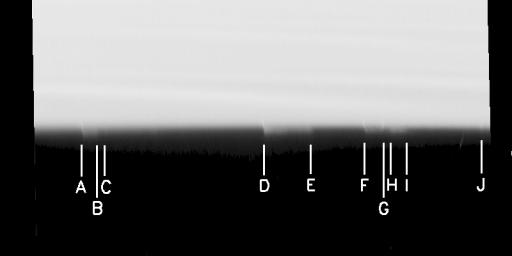Images taken of Saturn's rings by Cassini immediately after it entered orbit around Saturn have turned up circumstantial evidence that an unseen moon may be orbiting dead center in the narrow Keeler gap in Saturn's outer A ring.
The Keeler gap, a narrow gap calculated from Cassini images to be 42 kilometers (26 miles) wide, lies approximately 250 kilometers (155 miles) inside the outer edge of the A ring. Several faint discontinuities, or spikes, in the outer gap edge have been discovered in two narrow angle camera images of the illuminated side of the rings taken immediately after Saturn orbit insertion. One of these images has been mapped into a longitude-radius system, contrast enhanced and stretched by a factor of five, and is shown here. The longitudinal extent of the map is 4.6 degrees; the radial extent, top to bottom, is about 60 kilometers (37 miles). The most easily seen spikes are labeled A through J in this image.
These features are similar to the spikes protruding inward from the core of the F ring during Prometheus's passages (See PIA06143). Wisps of faint material, vaguely reminiscent of the drapes and striations seen interior to the F ring, are seen in association with, and between, some of these spikes in the Keeler gap edge. These features all move in unison at the orbital speed appropriate for particles at this location. Arguing on the basis of their similarity to the features caused by Prometheus in the F ring, it is likely that the features are caused by the passages of a yet-unseen moonlet on an eccentric orbit within the Keeler gap. The spikes are about 5 kilometers (3 miles) long. The putative moon would have a diameter of a few kilometers.
The most statistically significant characteristic spacing of the Keeler gap spikes has been found to be 199 kilometers (124 miles). A set of features with this particular wavelength, could be produced if a moon on an eccentric orbit were orbiting 21 kilometers (13 miles) away from the gap edge; i.e., dead center in the gap.
The Cassini-Huygens mission is a cooperative project of NASA, the European Space Agency and the Italian Space Agency. The Jet Propulsion Laboratory, a division of the California Institute of Technology in Pasadena, manages the mission for NASA's Science Mission Directorate, Washington, D.C. The Cassini orbiter and its two onboard cameras were designed, developed and assembled at JPL. The imaging team is based at the Space Science Institute, Boulder, Colo.
For more information about the Cassini-Huygens mission, visit http://saturn.jpl.nasa.gov and the Cassini imaging team home page, http://ciclops.org.

 Planetary Data System
Planetary Data System












